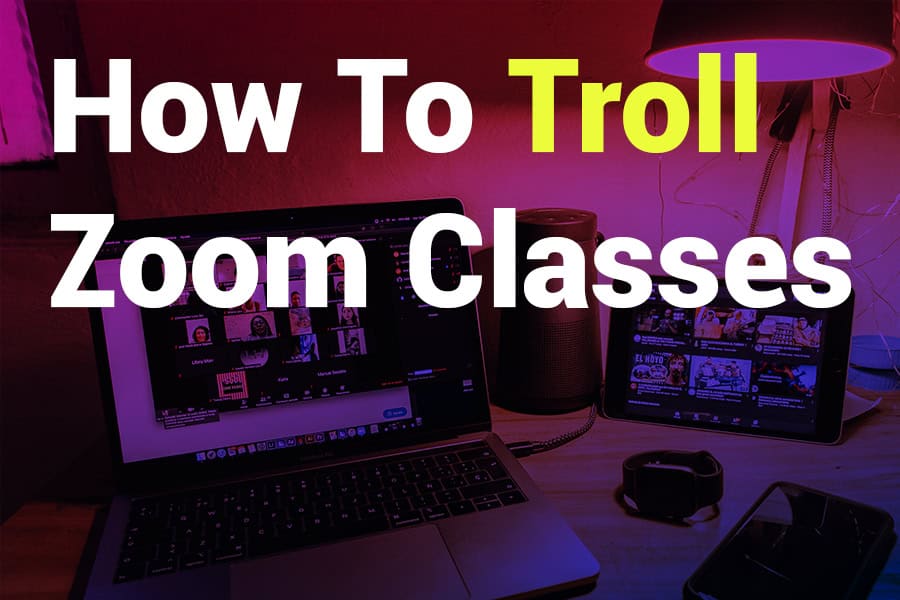As virtual learning becomes an essential part of education, Zoom classes have become the primary mode of instruction for millions of students worldwide. While these setups provide convenience and accessibility, they can sometimes feel monotonous and repetitive. Sitting in front of a screen for hours, with limited interaction, can make it hard for students to stay engaged and entertained.
This is where the concept of “Zoom trolling” comes in—a lighthearted, fun way to spice up the virtual classroom environment. Zoom trolling doesn’t have to be disruptive;, with a respectful and thoughtful approach, it can even enhance the class atmosphere. By introducing humor, playful virtual backgrounds, and subtle name changes, students can add a dash of fun to online learning.
In this guide, we’ll explore creative ways to “troll” Zoom classes respectfully. Each tip ensures that the class environment remains intact while allowing for a bit of comic relief. So, whether you’re trying to break the ice or lighten the mood, here are some harmless ways to liven up your next Zoom class!
Why Do People Want to Troll Zoom Classes?
Zoom classes provide a necessary shift to remote learning, yet they also come with challenges that make them less engaging than in-person settings. Here’s an in-depth look at why students find “trolling” Zoom classes tempting and often enjoyable. This section will explore the reasons behind this phenomenon and how harmless humor can make virtual learning more enjoyable for everyone.
Breaking the Monotony of Virtual Classes
Day after day, attending Zoom classes with little variation can lead to fatigue. Unlike traditional classrooms where students can interact, move around, and enjoy varied experiences, virtual classes are more static. This often leads students to seek ways to introduce variety and excitement into the mix. Harmless trolling offers a way to break this monotony and create a more engaging environment.
Promoting Engagement and Interaction
In a virtual setting, meaningful interactions are often limited, which can make students feel isolated. Light-hearted trolling allows for a shared experience that builds camaraderie among classmates. When done respectfully, these interactions can foster a sense of connection, encouraging students to actively participate in discussions.
Allowing Self-Expression in an Otherwise Formal Setting
One of the best aspects of online classes is the freedom to personalize one’s experience. Virtual backgrounds, funny display names, and sound effects allow students to express their personality and humor. Zoom trolling is often an attempt to bring out individual creativity and self-expression in a structured, sometimes formal, virtual environment.
Adding Humor to Reduce Stress
With academic pressures and the isolating nature of remote learning, students may experience stress. A bit of humor, especially in a non-disruptive form, can lighten the mood and make classes feel more enjoyable. Zoom trolling can serve as a quick stress reliever, allowing both students and teachers to share a laugh and ease the tension in class.
Encouraging a Positive Learning Environment
In the right context, trolling can contribute to a positive learning environment. When everyone’s laughing and relaxed, participation rates tend to increase. Respectful and well-timed trolling can add to the learning experience, making the classroom feel less rigid and more welcoming.
How to Troll Zoom Classes Using Virtual Backgrounds
Using creative virtual backgrounds is one of the most popular and least disruptive ways to troll Zoom classes. From funny memes to iconic movie scenes, virtual backgrounds can inject humor into any session. Here’s a detailed look at how to use them effectively.
Choose Unexpected Backgrounds
One easy way to get a laugh out of your classmates is by choosing a background that’s completely unexpected. Consider using popular memes or surreal images, like being in outer space, underwater, or in a famous movie scene. These backgrounds can offer a humorous twist to the class and give everyone a shared laugh without any real distraction from the lesson.
Change Backgrounds Mid-Class
For added effect, consider changing your virtual background periodically during the class. This might surprise your classmates and add a fun, dynamic element to the Zoom session. Whether it’s switching from a beach setting to a busy café or from a desert to an underwater world, these changes can make the class more interesting.
Be Creative with Relatable Imagery
A great tactic is to choose relatable or situational images. If you’re in a particularly challenging class, an image of someone “deep in thought” or “cramming for a test” can add some humor to the experience. This is an easy way to poke fun at the situation without detracting from the class.
Use Your Background to Make Inside Jokes
If you know your classmates well, you could use backgrounds that reference inside jokes or shared experiences. This is especially effective in smaller classes where students and teachers know each other better, making the joke relevant and enjoyable for everyone involved.
Keep It Respectful and Classroom-Friendly
Although virtual backgrounds can be funny, it’s essential to keep them appropriate for a classroom setting. Avoid using any images that might be considered offensive or distracting. Remember, the goal is to enhance the class atmosphere with humor, not disrupt it.
Funny Display Names to Use in Zoom Classes
Sometimes, a clever display name is all it takes to get a laugh. Here’s how to make your Zoom name entertaining yet respectful.
Using a playful or unexpected display name is an easy way to add humor without disrupting the class. Here are a few ideas to inspire you:
- Use Fictional Character Names: Channel your inner Harry Potter, Sherlock Holmes, or Marvel superhero.
- Choose a Lighthearted Title: Something like “Zoom Master” or “Professor of Procrastination” can spark a laugh.
- Try a Food-Themed Name: Go by “Captain Taco,” “Professor Pizza,” or “Sushi Supremo.”
- Opt for Alliteration: Alliteration adds a rhythmic humor, like “Silly Sally” or “Busy Ben.”
- Add Humor with Misnomers: A name like “Here for Extra Credit” or “Mute Button Fan” pokes fun at common Zoom frustrations.
These display names can bring light-hearted humor to the virtual space, but remember to keep them appropriate for an academic setting.
How to Use Sound Effects to Lightly Troll Zoom Classes?
Adding sound effects sparingly can be a fun, engaging way to add humor without major disruption. Here are tips on how to do it right.
1. Use Subtle Sound Effects Sparingly
Rather than blasting loud noises, consider adding soft chimes, light applause, or humorous but quiet sounds. A quick “ding” after someone makes a great point can feel supportive rather than disruptive. The key is to keep the volume low and the effect subtle.
2. Pick a Theme That Fits the Class
Tailor your sound effects to the topic at hand. If it’s a history class, a quiet “marching” sound or distant trumpets could add flair without being overbearing. This thematic approach keeps the humor relevant and enhances the overall learning experience.
3. Limit Frequency
Overusing sound effects can quickly shift from funny to annoying. Limit yourself to a few sound effects per class to keep things entertaining without crossing the line into disruption.
4. Cue Sound Effects at Appropriate Moments
Timing is everything. Use sound effects during pauses, introductions, or discussions when humor can relieve tension. Avoid using sound effects during crucial parts of the lecture, like explanations of complex concepts.
5. Always Have a Mute Button Ready
Be ready to turn off sound effects at a moment’s notice if they become distracting or if the instructor requests it. Respect the overall flow of the class to keep your trolling lighthearted and positive.
When and How to Troll Zoom Classes Respectfully?
Knowing when and how to add humor to Zoom classes is crucial to ensuring your antics are appreciated rather than disruptive. Here’s a guide to doing it right.
Understand the Class Atmosphere
Not all classes are suitable for trolling. In some courses, instructors encourage lightheartedness, while others prefer a more formal setting. Before trying anything humorous, take some time to assess the atmosphere and gauge whether your trolling will be welcome.
Save Trolling for Breaks or Casual Moments
Rather than trolling during lectures, save your humor for casual conversations, class discussions, or designated breaks. This approach keeps things light-hearted without interrupting important instructional time.
Avoid Anything Offensive
Keep your jokes and antics in good taste. Choose humor that’s inclusive, friendly, and won’t offend anyone. Avoid political references, sensitive topics, or anything that could be taken out of context.
Keep a Balance Between Fun and Focus
While trolling can add a fun dimension to Zoom classes, it’s essential to ensure it doesn’t take over the session. Balance is key to keeping things engaging while respecting the purpose of the class.
Conclusion
Incorporating respectful and light-hearted trolling in Zoom classes can improve engagement and bring joy to remote learning. By using creative backgrounds, clever display names, and well-timed sound effects, students can create a lively, inclusive atmosphere that enhances virtual classroom experiences. Remember, the goal is to entertain, not disrupt, and to add to the learning environment in a way that keeps everyone smiling.
FAQ’s
Q. Is it okay to “troll” in Zoom classes?
A. Light-hearted trolling is often acceptable but check with your teacher to make sure it’s appropriate for the setting.
Q. What are some fun backgrounds for Zoom classes?
A. Great options include iconic movie scenes, relatable meme images, and situational backgrounds like the beach or outer space.
Q. Can sound effects add humor without disruption?
A. Yes, if used sparingly and at appropriate times. Keep the volume low and save effects for lighter class moments.
Q. Should I change my Zoom display name?
A. Many students enjoy using fun names as long as they are appropriate and friendly.
Q. What are other ways to make Zoom classes more engaging?
A. Active participation, creative backgrounds, and sharing relevant media can make virtual classes feel more interactive and enjoyable.












































Leave a Reply